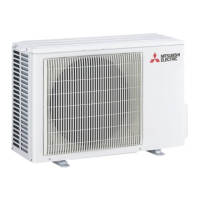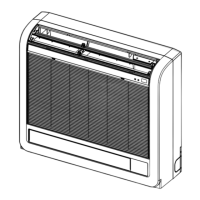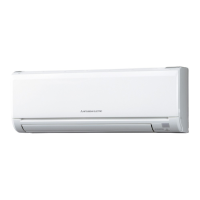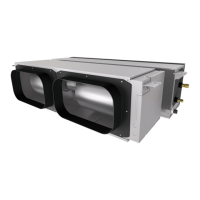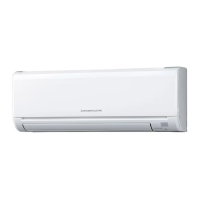-
29
-
R32 REFRIGERANT USED
CAUTION
1. General
• The installation of pipe-work shall be k kept to a
minimum.
• Pipe-work shall be protected from physical damage.
• Compliance with national gas regulations shall be
observed.
• Mechanical connections shall be accessible for
maintenance purposes.
• Keep any required ventilation openings clear of
obstruction.
• Servicing shall be performed only as recommended
by the manufacturer.
• Equipment piping in the occupied space shall be
installed in such a way to protect against accidental
damage in operation and service.
• Precautions shall be taken to avoid excessive
vibration or pulsation to refrigerating piping.
•
protected as far as possible against adverse effects
for example, the danger of water collection and
freezing in relief pipes or the accumulation of dirt
and ebris.
• Provision shall be made for expansion and
contraction of long runs of piping.
• Piping in refrigerating systems shall be designed and
installed to minimize the likelihood hydraulic shock
damaging the system.
• The indoor equipment and pipes shall be securely
mounted and guarded to avoid accidental rupture of
equipment from moving furniture or reconstruction
activities.
2. Unventilated areas
• The appliance shall be stored in a well-ventilated
area where the room size corresponds to the room
3.
• The staff in servicing operations must hold the
4. Information on servicing
4.1 Checks to the area
• Prior to beginning work on systems containing
necessary to ensure that the risk of ignition is
minimised.
• For repair to the refrigerating system, 4.2 to 4.6
shall be completed prior to conducting work on the
system.
4.2 Work procedure
• Work shall be undertaken under a controlled
gas or vapour being present while the work is being
performed.
4.3 General work area
• All maintenance staff and others working in the
local area shall be instructed on the nature of work
being carried out.
•
4.4 Checking for presence of refrigerant
• The area shall be checked with an appropriate
refrigerant detector prior to and during work, to
ensure the technician is aware of potentially toxic or
• Ensure that the leak detection equipment being
used is suitable for use with all applicable
refrigerants, i.e.
non-sparking, adequately sealed or intrinsically
safe.
4.5
• If any hot work is to be conducted on the
refrigerating equipment or any associated parts,
available to hand. Have a dry powder or CO2
extinguisher adjacent to the charging area.
4.6 No ignition sources
• No person carrying out work in relation to a
refrigerating system which involves exposing any pipe
work shall use any sources of ignition such a manner
• All possible ignition sources, including cigarette
site of installation, repairing, removing and disposal,
during which refrigerant can possibly be released to
the surrounding space.
• Prior to work taking place, the area around the
equipment is to be surveyed to make sure that there
• ”No Smoking” signs shall be displayed.
4.7 Ventilated area
• Ensure that the area is in the open or that it is
adequately ventilated before breaking into the
system or conducting any hot work.
• A degree of ventilation shall continue during the
period that the work is carried out.
• The ventilation should safely disperse any released
refrigerant and preferably expel it externally into the
atmosphere.
4.8 Checks to the refrigerating equipment
• Where electrical components are being changed,
• At all times the manufacturer’s maintenance and
service guidelines shall be followed.
• If in doubt consult the manufacturer’s technical
department for assistance.
• The following checks shall be applied to
– the actual refrigerant charge size is in accordance
with the room size within which the refrigerant
containing parts are installed.
– the ventilation machinery and outlets are
operating adequately and are not obstructed;
– if an indirect refrigerating circuit is being used,
the secondary circuit shall be checked for the
presence of refrigerant,
– marking to the equipment continues to the visible
and legible. Markings and signs that are illegible
shall be corrected,
– refrigerating pipe or components are installed in
a position where they are unlikely to e exposed
to any substance which may corrode refrigerant
containing components, unless the components
are constructed of materials which are inherently
resistant to being corroded or are suitably
protected against being so corroded.
4.9 Checks to electrical devices
• Repair and maintenance to electrical components
shall include initial safety checks and component
inspection procedures.
• If a fault exists that could compromise safety, then
no electrical supply shall be connected to the circuit
until it is satisfactorily dealt with.
• It the fault cannot be corrected immediately but it
is necessary to continue operation, an adequate
temporary solution shall be used.
• This shall be reported to the owner of the
equipment so all parties are advised.
• Initial safety checks shall include:
– that capacitors are discharged: this shall be done
in a safe manner to avoid possibility of sparking;
– that no live electrical components and wiring are
exposed while changing, recovering or purging
the system.
– that there is continuity of earth bonding.
5. Repairs to sealed components
• During repairs to sealed components, all electrical
supplies shall be disconnected from the equipment
being worked upon prior to any removal of sealed
covers, etc.
• If it is absolutely necessary to have an electrical
supply to equipment during servicing then a
permanently operating from of leak detection shall
be located at the most critical point to warm of a
potentially hazardous situation.
• Particular attention shall be paid to the following to
ensure that by working on electrical components,
the casing is not altered in such a way that the level
of protection is affected.
This shall include damage to cables, excessive
number of connections, terminals not made to
WARNING
is leaked, together with an external ignition source, there is a
possibility of ignition.
There is information included in the user’s manual and/or
installation manual.
The user’s manual should be read carefully.
A service personnel should be handing this equipment with
reference to the installation manual.
• This safety precaution sheet is for R32 refrigerant. If you want to know the type of refrigerant in the unit, check the label attached to the outdoor unit.
• The precautionary items mentioned below are distinguished into two levels,
WARNING
and
CAUTION
.
WARNING
: Wrong installation would cause serious consequences such as injuries or death.
CAUTION
: Wrong installation might cause serious consequences depending on circumstances.
• Strict compliance of the domestic laws must be
observed when disposing the appliance.
• Do not use means to accelerate the defrost operation
process or to clean, other than those recommended
by the manufacturer.
• The appliance shall be stored in a room without
continuously operating ignition sources (for example:
operating electric heater.
• Do not pierce or burn.
• Be aware that refrigerants may not contain an
odour.
CAUTION
• Ensure that the apparatus is mounted securely.
• Ensure that seals or sealing materials have not
degraded to the point that they no longer serve the
atmospheres.
• Replacement parts shall be in accordance with the
6. Repair to intrinsically safe components
• Do not apply any permanent inductive or
capacitance loads to the circuit without ensuring
that this will not exceed the permissible voltage
and current permitted for the equipment in use.
• Intrinsically safe components are the only types that
can be worked on while live in the presence of a
• The test apparatus shall be at the correct rating.
•
the manufacturer.
• Other parts may result in the ignition of refrigerant
in the atmosphere from a leak.
NOTE
The use of silicone sealant can inhibit the
effectiveness of some types of leak detection
equipment. Intrinsically sate components do not have
to be insulated prior to working on them.
7. Cabling
• Check that cabling will not be subject to wear,
corrosion, excessive pressure, vibration, sharp
edges or any other adverse environmental effects.
The check shall also take into account the effects
of aging or continual vibration from sources such as
compressors or fans.
8.
• Under no circumstances shall potential sources of
ignition be used in the searching for or detection of
refrigerant leaks.
• A halide torch (or any other detector using a naked
• Electronic leak detectors may be used to detect
refrigerants, the sensitivity may not be adequate, or
may need re-calibration. (Detection equipment shall
be calibrated in a refrigerant-free area.)
• Ensure that the detector is not a potential source of
ignition and is suitable for the refrigerant used.
• Leak detection equipment shall be set at a percentage
of the LFL of the refrigerant and shall be calibrated to
the refrigerant employed, and the appropriate
•
refrigerants but the use of detergents containing
chlorine shall be avoided as the chlorine may react
with the refrigerant and corrode the copper pipe-work.
– bubble method
–
•
removed/extinguished.
• If a leakage of refrigerant is found which requires
brazing, all of the refrigerant shall be recovered from
the system, or isolated (by means of shut off valves)
in a part of the system remote from the leak.
• Removal of refrigerant shall be according to Item.9.
9. Removal and evacuation
• When breaking into the refrigerant circuit to make
repairs - or for any other purpose - conventional
refrigerants it is important that best practice is
• The following procedure shall be adhered to:
– remove refrigerant;
– purge the circuit with inert gas; (optionfor A2L)
– evacuate;(option for A2L)
– purge with inert gas ;(option for A2L)
– open the circuit by cutting or brazing.
• The refrigerant charge shall be recovered into the
correct recovery cylinders.
•
other than A2L refrigerans, the system shall be
• This process may need to be repeated several
times.
• Compressed air or oxygen shall not be used for
purging refrigerant systems.
•
other than A2L refrigerants, refrigerants purging
shall be achieved by breaking the vacuum in the to
system with oxygen-free nitrogen and continuing
a vacuum.
• This process shall be repeated until no refrigerant
is within the system.
•
the system shall be vented down to atmospheric
pressure to enable work to take place.
• This operation is absolutely vital if brazing
operations on the pipe-work are to take place.
• Ensure that the outlet for the vacuum pump is not
close to any ignition sources and that ventilation is
available.
10. Charging procedures
• In addition to conventional charging procedures, the
following requirements shall be followed.
– Ensure that contamination of different refrigerants
dose not occur when using charging equipment.
Hoses of lines shall be as short as possible to
minimise the amount of refrigerant contained in
them.
– Cylinders shall be kept in an appropriate
according to the instructions.
– Ensure that the refrigerating system is earthed
prior to charging the system with refrigerant.
– Label the system when charging is complete (if
not already).
refrigerating system.
• Prior to recharging the system, it shall be pressure-
tested with the appropriate purging gas.
• The system shall be leak-tested on completion of
charging but prior to commissioning.
• A follow up leak test shall be carried out prior to
leaving the site.
11. Decommissioning
• Before carrying out this procedure, it is essential
that the technician is completely familiar with the
equipment and all its detail.
• It is recommended good practice that all
refrigerants are recovered safely.
• Prior to the task being carried out, an oil and
refrigerant sample shall be taken in case analysis is
required prior to re-use of recovered refrigerant.
• It is essential that electrical power is available
before the task is commenced.
a)
Become familiar with the equipment and its operation.
b) Isolate system electrically.
c) Before attempting the procedure ensure that
– mechanical handling equipment is available, if
required, for handling refrigerant cylinders,
– all personal protective equipment is available and
being used correctly,
– the recovery process is supervised at all times by
a competent person,
– recovery equipment and cylinders conform to the
appropriate standards.
d) Pump down refrigerant system, if possible.
e) If a vacuum is not possible, make a manifold so
that refrigerant can be removed from various parts
of the system.
f) Make sure that cylinder is situated on the scales
before recovery takes place.
g) Start the recovery machine and operate in
accordance with instructions.
volume liquid charge).
i) Do not exceed the maximum working pressure of
the cylinder, even temporarily .
j)
and the process completed, make sure that the
cylinders and the equipment are removed from site
promptly and all isolation valves on the equipment
are closed off.
k) Recovered refrigerant shall not be charged into
another refrigerating system unless it has been
cleaned and checked.
12. Labelling
• Equipment shall be labelled stating that it has been
de-commissioned and emptied of refrigerant.
The label shall be dated and signed.
•
ensure that there are labels on the equipment
refrigerant.
13. Recovery
• When removing refrigerant from a system, either for
servicing or decommissioning, it is recommended
good practice that all refrigerants are removed safely.
• When transferring refrigerant into cylinders, ensure
that only appropriate refrigerant recovery cylinders
are employed.
• Ensure that the correct number of cylinders for
holding the total system charge is available.
• All cylinders to be used are designated for
the recovered refrigerant and labelled for that
refrigerant (i.e. special cylinders for the recovery of
refrigerant).
• Cylinders shall be complete with pressure relief
valve and associated shut-off valves in good
working order.
• Empty recovery cylinders are evacuated and, if
possible, cooled before recovery occurs.
• The recovery equipment shall be in good working
order with a set of instructions concerning the
equipment that is at hand and shall be suitable
for the recovery of all appropriate refrigerants
• In addition, a set of calibrated weighing scales shall
be available and in good working order.
• Hoses shall be complete with leak-free disconnect
couplings and in good condition.
• Before using the recovery machine, check that it
is in satisfactory working order, has been properly
maintained and that any associated electrical
components are sealed to prevent lignition in the
event of a refrigerant release.
Consult manufacturer if in doubt.
• The recovered refrigerant shall be retumed to the
refrigerant supplier in the correct recovery cylinder,
and the relevant Waste Transfer Note arranged.Do
not mix refrigerants in recovery units and especially
not in cylinders.
• If compressors or compressor oils are to be
removed, ensure that they have been evacuated to
refrigerant dose not remain within the lubricant.
• The evacuation process shall be carried out prior to
returning the compressor to the suppliers.
• Only electric heating to the compressor body shall
be employed to accelerate this process.
• When oil is drained from a system, it shall be
carried out safely.
14. Other safety precautions
• A brazed, welded, or mechanical connection shall be
made before opening the valves to permit refrigerant
• Flammable refrigerant used, refrigerant tubing
protected or enclosed to avoid mechanical damage
(IEC/EN 60335-2-40/A1).
• Tubing protected to extent that it will not be handled
or used for carrying during moving of product (IEC/
EN 60335-2-40/A1).
• Flammable refrigerant used, low temperature solder
alloys, such as lead/tin alloys, not
acceptable for pipe connections
(IEC/EN 60335-2-40/A1).
•
procured.
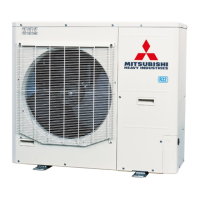
